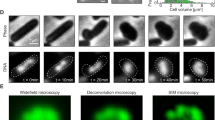Abstract
Considerable progress has been made in the chemical characterization of the origin of replication of the bacterial chromosome in both Escherichia coli and Bacillus subtilis1–4. This region is important in the initiation and control of replication. The replication terminus, or position at which the two replication forks meet, is located opposite the origin, but its structure is unknown despite its several interesting properties which, almost certainly, reflect a significant biological role in the overall cell cycle—it seems to inhibit the movement of replication forks5,6, it is remarkably devoid of genetic information7,8 and, like the origin, it shows a specific interaction with the cell surface, probably the membrane9. Recently, it was shown that the sporulation process in B. subtilis could be used to label the bacterial chromosome terminus radioactively10,11. Here we have investigated the number and nature of the labelled DNA fragments generated by restriction endonuclease treatment of chromosomes labelled over progressively shorter distances in the vicinity of the terminus. The results show that termination of B. subtilis chromosome replication is a more specific process than it has hitherto been possible to establish. Furthermore, the findings open the way to structural studies on the terminus region and to an examination by a very direct approach of the movement of replication forks within it.
This is a preview of subscription content, access via your institution
Access options
Subscribe to this journal
Receive 51 print issues and online access
$199.00 per year
only $3.90 per issue
Buy this article
- Purchase on Springer Link
- Instant access to full article PDF
Prices may be subject to local taxes which are calculated during checkout
Similar content being viewed by others
References
Marsh, R. C. & Worcel, A. Proc. natn. Acad. Sci. U.S.A. 74, 2720–2724 (1977).
Meijer, M. et al. Proc. natn. Acad. Sci. U.S.A. 76, 580–584 (1979).
Sugimoto, K. et al. Proc. natn. Acad. Sci. U.S.A. 76, 575–579 (1979).
Seiki, M., Ogasawara, N. & Yoshikawa, H. Nature 281, 699–701 (1979).
Kuempel, P. L., Duerr, S. A. & Seeley, N. R. Proc. natn. Acad. Sci. U.S.A. 74, 3927–3931 (1977).
Louarn, J., Patte, J. & Louarn, J.-M. J. molec. Biol. 115, 295–314 (1977).
Bachmann, B. J. & Low, K. B. Microbiol. Rev. 44, 1–56 (1980).
Henner, D. J. & Hoch, J. A. Microbiol. Rev. 44, 57–82 (1980).
Hye, R. J., O'Sullivan, A., Howard, K. & Sueoka, N. in Microbiology 1976 (ed. Schlessinger, D.) 83–90 (American Society for Microbiology, Washington, DC, 1976).
Adams, R. T. & Wake, R. G. J. Bact. 143, 1036–1038 (1980).
Sargent, M. G. J. Bact. 143, 1033–1035 (1980).
Author information
Authors and Affiliations
Rights and permissions
About this article
Cite this article
Weiss, A., Hariharan, I. & Wake, R. Analysis of the terminus region of the Bacillus subtilis chromosome. Nature 293, 673–675 (1981). https://doi.org/10.1038/293673a0
Received:
Accepted:
Issue Date:
DOI: https://doi.org/10.1038/293673a0
Comments
By submitting a comment you agree to abide by our Terms and Community Guidelines. If you find something abusive or that does not comply with our terms or guidelines please flag it as inappropriate.



